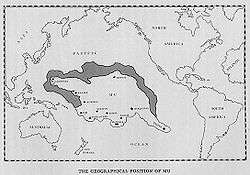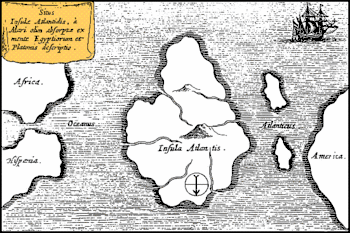List of lost lands
Lost Lands are islands or continents believed by some to have existed during pre-history, but to have since disappeared as a result of catastrophic geological phenomena. Such continents are generally thought to have subsided into the sea, leaving behind only a few traces or legends by which they may be known.

Legends of lost lands often originated as scholarly or scientific theories, only to be picked up by writers and individuals outside the academy. Occult and New Age writers have made use of Lost Lands, as have subaltern peoples such as the Tamils in India.
Phantom Islands, as opposed to Lost Lands, are land masses formerly believed by cartographers to exist in the current historical age, but to have been discredited as a result of expanding geographic knowledge.
The classification of lost lands as continents, islands, or other regions is in some cases subjective; for example, Atlantis is variously described as either a "lost island" or a "lost continent". Lost land theories may originate in mythology or philosophy, or in scholarly or scientific theories, such as catastrophic theories of geology.
Lost continents
In the 1954 book Lost Continents by L. Sprague de Camp, he describes many modern writers who have speculated about ancient civilizations that existed on continents now deluged under the sea.[1] According to de Camp, there is no real scientific evidence for any lost continents whatsoever.
- The most famous lost continent is Atlantis. Atlantis, like Hyperborea and Thule, is ultimately derived from ancient Greek geographic speculation and possibly memories of the Minoan eruption of the Thera volcano.
- The name of hypothetical vanished continent Mu originated from the first attempted translation of the Madrid Codex, one of only four remaining Maya codices.
- Zealandia, a scientifically accepted continent that is now 94% submerged under the Pacific Ocean, surrounding the areas of New Zealand and New Caledonia.
- A land connecting India and South Africa was believed by some to exist at various times. Lemuria and Kumari Kandam.
Submerged lands

Although the existence of lost continents in the above sense is mythical (aside from Zealandia), there were many places on Earth that were once dry land but submerged after the ice age around 10,000 BCE due to rising sea levels, and possibly were the basis for Neolithic and Bronze Age flood myths. Some others were lost due to coastal erosion or volcanic eruptions. Approximately listed by size, these are:
- Atlit Yam, an ancient submerged Neolithic village off the coast of Atlit, Israel.
- Heracleion, an ancient Egyptian city located near the Canopic Mouth of the Nile, about 32 km (20 miles) northeast of Alexandria.
- Sundaland, the now submerged Sunda Shelf.
- Kerguelen Plateau, a submerged micro-continent which is now 1–2 km below sea level.
- Beringia, connecting Asia and North America.
- Doggerland, the bed of the North Sea, which once connected Great Britain to Continental Europe before being inundated by rising sea levels during the Holocene.
- A large island in the Mediterranean Sea, of which Malta is the only part not now submerged.
- Maui Nui, once a large island of the Hawaii archipelago; several major islands represent residual high ground of Maui Nui.
- New Moore Island, an island in the Bay of Bengal submerged in 2010 by rising sea levels.
- Pavlopetri, sunken city off the coast of southern Laconia in Peloponnese, Greece,
- Verdronken Land van Reimerswaal, most of this region in The Netherlands vanished in a storm in 1532; the town of Reimerswaal survived as an island into the 17th century; the last bits of land vanished in the early 19th century.
- Strand, an island off the German coast with the town Rungholt, eroded away by storm surges before being washed away by a final flood in 1634.
- Jomsborg and Vineta, legendary cities on the south coast of the Baltic Sea supposed to have been submerged in the Middle Ages.
- Jordsand, once an island off the Danish coast, eroded away by storm surges before being washed away by a final flood between 1998 and 1999.
- Ferdinandea, submerged volcanic island which has appeared at least four times in the past.
- Sarah Ann Island, now submerged guano island, located just north of the equator. Vanished between 1917 and 1932.
- Ravenser Odd, a large 13th-century town on an old sandbank promontory in East Yorkshire, which became an island and then vanished in January 1392.
- Dunwich, the traditional capital of the Kingdom of the East Angles that was lost to the sea by gradual coast erosion and partly by a storm surge in 1286.
- Dadu Island, which was legally the southernmost point of the United States of America, located at Palmyra Atoll and still shown on the map (an incorporated U.S. territory), was a bare sand islet washed away by a storm in 2014. (It was named after a dog "Dadu" that had lived at the atoll.[2])
Mythological lands
- Agartha, in the Hollow Earth.
- Atlantis, Plato's utopian paradise.
- Avalon, the mythical lost land or island in Arthurian, Cornish and Welsh legend.
- Buyan, an island with the ability to appear and disappear in Slavic mythology.
- Cantre'r Gwaelod, in Welsh legend, the ancient sunken realm said to have occupied a tract of fertile land lying between Ramsey Island and Bardsey Island in what is now Cardigan Bay to the west of Wales.
- Iram of the Pillars, a reference to a lost city, country or area mentioned in the Qur'an.
- Kitezh, a legendary underwater city located in Russia, populated by spiritual people.
- Kumari Kandam, a mythical lost continent in the Indian Ocean
- Lemuria, a mythical lost continent with an ancient Tamil civilization in the Indian or the Pacific Ocean.
- Llys Helig Welsh legends regarding the local rock formations conceal the palace of Prince Helig ap Glanawg, said to be part of a larger drowned kingdom near Penmaenmawr, Wales.
- Lyonesse in Arthurian literature, it was the home of Tristan and is associated with the Isles of Scilly, Cornwall (an area inundated by the sea c.2500BC), the tale parallels the Welsh and particularly Breton legendary lost lands.
- Mu, a legendary lost continent in the Pacific Ocean
- Shangri-La, a fictitious valley in Tibet the idea of which may have been inspired by the myth of Shambhala
- Quivira and Cibola, also known as the Seven Cities of Gold. These were suspected somewhere in America by the Conquistadors.
- El Dorado, mythic city of gold.
- Ys, a mythical drowned city in Brittany, similar to other Celtic lost lands in Welsh and Cornish tradition. Most versions of the legend place the city in the Baie de Douarnenez.
Phantom islands
Phantom islands, as opposed to lost lands, are land masses formerly believed by cartographers to exist in the historical age, but to have been discredited as a result of expanding geographic knowledge. Terra Australis is a phantom continent. While a few phantom islands originated from literary works (an example is Ogygia from Homer's Odyssey), most phantom islands are the result of navigational errors.
In literature and philosophy
The following individuals are known for having written on the subject of lost lands (either as fiction, hypothesis, or supposed fact):
- H.P. Blavatsky
- Edgar Rice Burroughs (The Land That Time Forgot, Tarzan and the Jewels of Opar, At the Earth's Core)
- James Churchward
- Ignatius L. Donnelly
- Burak Eldem
- Warren Ellis
- Philip José Farmer
- Geoffrey of Monmouth first mention of Avalon in his Historia Regum Britanniae
- H. Rider Haggard
- Édouard Lalo (Le roi d'Ys)
- H. P. Lovecraft often invoked the names of lost lands of his own invention, a practice that subsequently gave birth to the Cthulhu mythos.
- Plato
- Augustus Le Plongeon
- Zecharia Sitchin
- J. R. R. Tolkien partially based the story of Númenor, referenced in The Lord of the Rings and The Silmarillion, on Atlantis.
- Samael Aun Weor
- Jack Vance (Lyonesse Trilogy)
See also
- Flood myths
- Lost city
- Lost World
- Vanishing island
- Tidal island
References
- L. Sprague de Camp (1954). Lost Continents: The Atlantis Theme in History, Science, and Literature. Gnome Press.
- "Requiem for a Shark Dog". December 2014.
Further reading
- L. Sprague de Camp and Willy Ley, Lands Beyond, Rinehart & Co., New York, 1952.
- L. Sprague de Camp, Lost Continents: The Atlantis Theme in History, Science, and Literature, Dover Publications, 1970.
